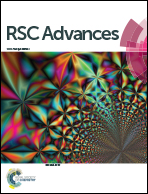Cu2ZnSnS4 quantum dots as effective electron acceptors for hybrid solar cells with a broad spectral response
Abstract
High-purity Cu2ZnSnS4 quantum dots (CZTS-QDs) with a size of 3–5 nm and a band gap of 1.67 eV are synthesized by a facile solvothermal method using simple chemicals in ethanol solvent. The CZTS-QDs have an ionization potential (IP) of −5.96 eV and an electron affinity (EA) of −4.33 eV, which are almost not changed after removal of capping molecules on them. Due to the favorable IP and EA positions with respect to those of poly(2-methoxy-5-(2-ethylhexyloxy)-1,4-phenylene vinylene) (MEH-PPV), the CZTS-QDs act as effective electron acceptors for hybrid solar cells based on polymer/CZTS blends with MEH-PPV as the polymer. CZTS-QDs and MEH-PPV form type-II heterojunctions to enable the solar cells to have a promising open-circuit voltage of 0.63 V, and the efficient charge separation for neutral excited states produced either on the polymer or on the CZTS-QDs makes the solar cells have a wide spectral response extending to 900 nm. It is revealed that removal of capping molecules on the quantum dots mainly leads to a reduced polymer exciton diffusion effect on the electron transport dynamics due to the formation of wider CZTS charge transport channels and an increased short-circuit current (Jsc) in the solar cells, where the enhanced Jsc dominantly correlates with the increased charge transfer and collection efficiencies due to the improved charge transport property in CZTS channels.


 Please wait while we load your content...
Please wait while we load your content...